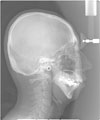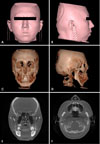1. Robin P. La chute de la base de la langue considérée comme une nouvelle cause de gêne dans la respiration nasopharyngienne. Bull Acad Med (Paris). 1923; 89:37–40.
2. Tan TY, Kilpatrick N, Farlie PG. Developmental and genetic perspectives on Pierre Robin sequence. Am J Med Genet C Semin Med Genet. 2013; 163C:295–305.

3. Izumi K, Konczal LL, Mitchell AL, Jones MC. Underlying genetic diagnosis of Pierre Robin sequence: retrospective chart review at two children’s hospitals and a systematic literature review. J Pediatr. 2012; 160:645–650.e2.

4. Smith DW, Theiler K, Schachenmann G. Rib-gap defect with micrognathia, malformed tracheal cartilages, and redundant skin: a new pattern of defective development. J Pediatr. 1966; 69:799–803.

5. Tooley M, Lynch D, Bernier F, Parboosingh J, Bhoj E, Zackai E, et al. Cerebro-costo-mandibular syndrome: clinical, radiological, and genetic findings. Am J Med Genet A. 2016; 170A:1115–1126.

6. Miller KE, Allen RP, Davis WS. Rib gap defects with micrognathia. The cerebro-costo-mandibular syndrome - a Pierre Robin-like syndrome with rib dysplasia. Am J Roentgenol Radium Ther Nucl Med. 1972; 114:253–256.
7. Smith KG, Sekar KC. Cerebrocostomandibular syndrome. Case report and literature review. Clin Pediatr (Phila). 1985; 24:223–225.
8. Rymer AN, Porteous GH, Neal JM. Anesthetic challenges in an adult with Pierre Robin sequence, severe juvenile scoliosis, and respiratory failure. A A Case Rep. 2015; 5:95–98.

9. Kim JH, Gansukh O, Amarsaikhan B, Lee SJ, Kim TW. Comparison of cephalometric norms between Mongolian and Korean adults with normal occlusions and well-balanced profiles. Korean J Orthod. 2011; 41:42–50.

10. Kim MS, Lee EJ, Song IJ, Lee JS, Kang BC, Yoon SJ. The location of midfacial landmarks according to the method of establishing the midsagittal reference plane in three-dimensional computed tomography analysis of facial asymmetry. Imaging Sci Dent. 2015; 45:227–232.

11. Nah KS. Condylar bony changes in patients with temporomandibular disorders: a CBCT study. Imaging Sci Dent. 2012; 42:249–253.

12. Ogasawara K, Honda Y, Hosoya M. Ex utero intrapartum treatment for an infant with cerebro-costo-mandibular syndrome. Pediatr Int. 2014; 56:613–615.
13. Matić A, Velisavljev-Filipović G, Lovrenski J, Gajdobranski D. A case of severe type of cerebro-costo-mandibular syndrome. Srp Arh Celok Lek. 2016; 144:431–435.

14. Leroy JG, Devos EA, Vanden Bulcke LJ, Robbe NS. Cerebro-costo-mandibular syndrome with autosomal dominant inheritance. J Pediatr. 1981; 99:441–443.

15. Merlob P, Schonfeld A, Grunebaum M, Mor N, Reisner SH. Autosomal dominant cerebro-costo-mandibular syndrome: ultrasonographic and clinical findings. Am J Med Genet. 1987; 26:195–202.

16. Silverman FN, Strefling AM, Stevenson DK, Lazarus J. Cerebro-costo-mandibular syndrome. J Pediatr. 1980; 97:406–416.

17. Lee SS, You DS. Radiographic study on maxillary sinus development and nasal septum deviation in cleft palate patient. J Korean Acad Oral Maxillofac Radiol. 1992; 22:305–313.
18. Lynch DC, Revil T, Schwartzentruber J, Bhoj EJ, Innes AM, Lamont RE, et al. Disrupted auto-regulation of the spliceosomal gene SNRPB causes cerebro-costo-mandibular syndrome. Nat Commun. 2014; 5:4483.

19. Bacrot S, Doyard M, Huber C, Alibeu O, Feldhahn N, Lehalle D, et al. Mutations in SNRPB, encoding components of the core splicing machinery, cause cerebro-costo-mandibular syndrome. Hum Mutat. 2015; 36:187–190.
20. Cohen SM, Greathouse ST, Rabbani CC, O'Neil J, Kardatzke MA, Hall TE, et al. Robin sequence: what the multidisciplinary approach can do. J Multidiscip Healthc. 2017; 10:121–132.

21. Wagener S, Rayatt SS, Tatman AJ, Gornall P, Slator R. Management of infants with Pierre Robin sequence. Cleft Palate Craniofac J. 2003; 40:180–185.













 PDF
PDF ePub
ePub Citation
Citation Print
Print



 XML Download
XML Download